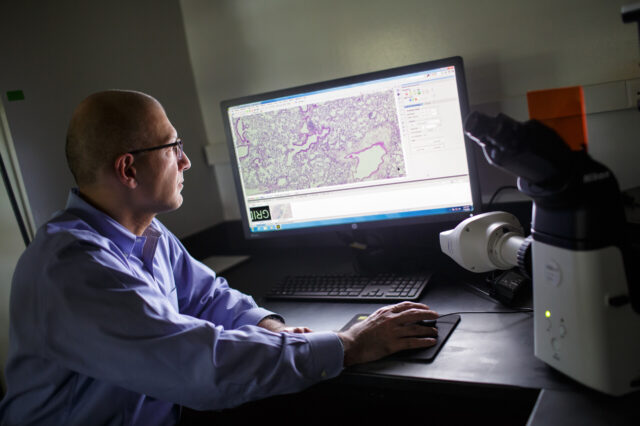Researchers awarded $2.7 million grant to fight deadly fungal infection

We constantly inhale Aspergillus mold spores, which live both indoors and outdoors, without becoming ill. But for people with a weakened immune system, a fungal infection caused by the spores could be fatal.
The deadly fungus will soon face a new weapon in the researcher’s arsenal — a computer algorithm that could help scientists better understand on the molecular level the labyrinthine interaction of the fungus with a living host.
A UF Health researcher and his collaborators have been awarded a $2.7 million National Institutes of Health grant to develop a computer model that could lead to new therapies to treat invasive Aspergillosis, a fungal disease caused by Aspergillus.
“Aspergillosis is common, and it’s becoming more and more common,” said Borna Mehrad, M.D., a professor and chief of the division of pulmonary, critical care & sleep medicine in the UF College of Medicine. “So, the infection is a tremendous problem.”
Susceptible patients include stem cell or organ transplant recipients, cancer patients undergoing chemotherapy and those on immunosuppressive drugs such as steroids. The Centers for Disease Control and Prevention does not tally the number of people afflicted with Aspergillosis because it is a non-reportable disease, but varying estimates peg mortality at 30 to 60 percent, even with tailored antibiotic treatments.
Mehrad, who has studied Aspergillosis most of his career, is collaborating with Reinhard Laubenbacher, Ph.D., a professor of computational biology at University of Connecticut Health and co-director of its Center for Quantitative Medicine, and Kitware, an Albany, New York software company.
Laubenbacher is developing the model’s algorithm, a set of instructions that is the beating heart of a computer program and can help it solve complex problems. Mehrad will do lab work in cell culture and mouse infection models and feed results to Laubenbacher. Kitware is working on a user interface.
Understanding the complex interaction of the fungus in the mouse model, and ultimately the human body, is a formidable hurdle for researchers.
Mehrad said he and Laubenbacher’s teams will focus on how the fungus, skirting immune defenses, thrives by releasing molecules that bind up iron in the body of its host.
“There is a fight between the bug and the host over iron,” said Mehrad. “The host is trying to hold onto iron and not give any to the fungus. The fungus has clever ways of scavenging iron away from the host.”
Starving the fungus of iron by turning off its ability to acquire it, or by strengthening the host’s ability to hide its iron, would prevent the disease from gaining a foothold in the body and causing an infection.
The usual approach for scientists trying to figure out ways to block the fungus, Mehrad said, involves a series of educated guesses on which of the many molecules the fungus and the host might use to bind iron.
“You say, ‘Let’s see if this molecule is important,’ and then go out and knock out that molecule,” he said. “You come up with your best guess and then test that hypothesis. As you might imagine, this is not very efficient.”
The better way is to have a sophisticated computer model predict those interactions.
The researchers have already worked on a simple model of one part of the lung. But the grant, Mehrad said, will allow them to vastly scale up complexity.
Mehrad and his lab will feed data to Laubenbacher and his team until the model becomes sufficiently sophisticated. Then the computer program will begin making its own predictions. “The computer will say it thinks a particular molecule is important,” Mehrad said.
He will then go into the lab and test the computer algorithm’s hypothesis on mouse models. If the molecule is unimportant and cannot be used to inhibit the fungi’s ability to take up iron, then that “negative data” will be fed back into the algorithm “so that the model gets one step more sophisticated,” Mehrad said.
The model behaves as a precocious child in a nurturing environment: It learns.
About the author
